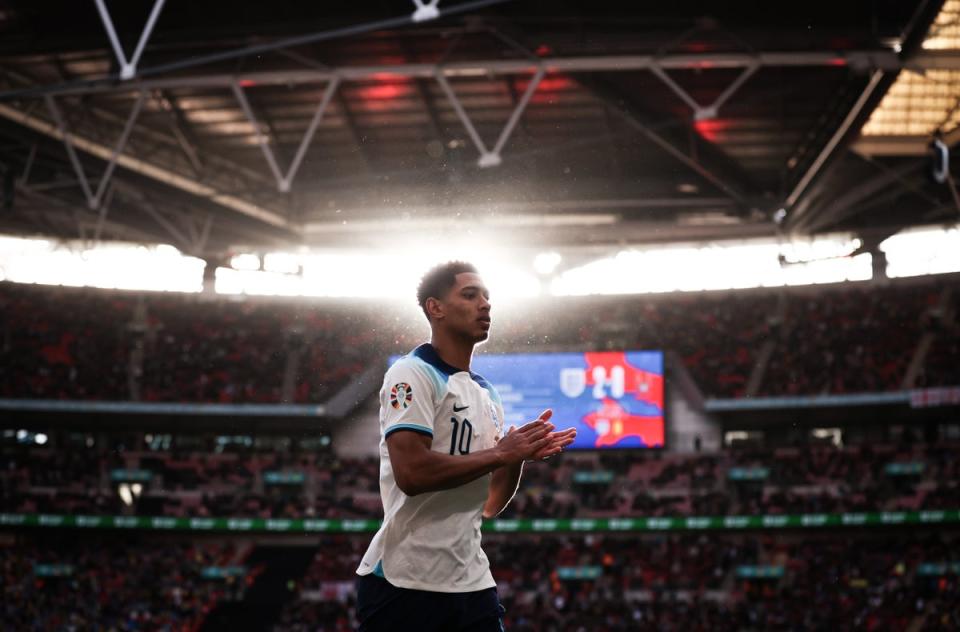Bellingham and Saka are the new untouchables in Southgate’s England 4.0

Across Europe, it is a time of new beginnings and new eras, of new players and new managers. That can be the way after major tournaments: disappointments lead to clearouts, international retirements to opportunities, different regimes to a shift in thinking and personnel. Then there is England. While change has been a guiding theme, whether for France or Germany, Spain or Italy, Gareth Southgate’s side have been Europe’s kings of continuity.
Two games have brought one brief debut, for Ivan Toney. Nine of their World Cup quarter-final starting 11 began the first Euro 2024 qualifier. If the broader theme is one of more of the same, but preferably with a different ending featuring the glint of silverware, the fixture list offered precious little scope for experimentation: not when the first game was Italy in Naples. With six points from six, the tried and trusted have passed their test. Southgate was considering his future until the World Cup. England now have added reasons to be glad he stayed on. This could have been a hospital pass of a start. “This would have been a complicated week for someone else to come in and take two matches with such a quick turnaround,” the manager said.
If Southgate 4.0 resembles Southgate 3.0, that is unsurprising. Southgate has wielded the axe with a brutality that can be camouflaged by his politeness: but his victims were Wayne Rooney and Joe Hart at the start of his reign. The second most successful spell in England’s chequered history has engendered loyalty. Kalvin Phillips – whose last league start was for Leeds – began against the current European champions. Harry Maguire, perhaps Manchester United’s fourth-choice centre-back, started wins against Italy and Ukraine. Neither selection was surprising.
His decision-making shows there are different definitions of meritocracy. Southgate may not always pick on club form, but he does reward those who have served him well. He may have become more reluctant to dispense with the deserving: Ashley Young did not figure again after the 2018 World Cup, but all of his starters in the 2022 tournament either have played again or will. He has chosen not to pension off the thirty-somethings Kyle Walker, Kieran Trippier and Jordan Henderson: as his tenure may only have 18 months to run, there is less need.
So there is no revolution. Superficially, perhaps, there is no evolution either. But maybe there is. This isn’t an attempt to freeze time, a hope that stasis will be a winning formula. The dynamics of a side are shifting. Even as Harry Kane amasses the records, this is now a team of two generations. Over the last few months, Bukayo Saka and Jude Bellingham have gone from promising performers to pivotal players. They now seem two of Southgate’s untouchables, precocious talents with impeccable attitudes.
Bellingham is the great all-rounder who has changed the tactics. “I’ve always wanted to be someone who can do a bit of everything,” he said, and he has facilitated the shift to a three-man midfield with his ability to be both No 8 and No 10. In turn, that has stopped England being so passive. “The counter pressure to win things back really quickly with those three midfield players in particular was outstanding,” said Southgate, attributing Ukraine’s lack of threat to his men in the middle. But when there were only two of them, in a 3-4-3 formation, they were too few to press. Nor could England have played with the midfield dominance they had in the first half against Italy.
Saka, meanwhile, has surged to the front of a packed queue for places on the flanks. It used to be Raheem Sterling and one other; now it is Saka on the right, with a fight to play on the left. Saka has added the productivity the best possess. “I think he knows that to be a really top wide player you need the numbers of goals and assists,” Southgate said, after a Saka assist and a sumptuous goal beat Ukraine.
It was long one of Sterling’s great attributes: he was England’s second scorer, after Kane. Now Saka may be. Misfortune may have hastened Sterling’s slide – the burglary that meant he briefly returned home during the World Cup, the injury that accounted for his absence now – and, at 28, he is younger than Kane. But at a point when Saka and Marcus Rashford have taken their games to the next level, Sterling is having his least productive season for six years. Minus Rashford, the role on the left against Ukraine went to the closest thing to a newcomer starting, with James Maddison’s second cap coming in a different decade to his first. “We were always going to start James,” Southgate said. But the shape of the side, when Kane drops off to act as a No 10, may mean a runner in behind is of more use on the left. That was long Sterling’s role: it will be instructive if it is Rashford’s or Phil Foden’s in June.
Sterling is not alone in slipping down the pecking order in absentia. c is also injured but feels the great loser from Bellingham’s brilliance. Giving the Borussia Dortmund teenager more licence to advance comes at a cost to the Chelsea man. With the back four entrenched now, and Walker’s pace seemingly undiminished by the passing of time, there look fewer opportunities for specialist right wing-backs.
Go back to the start of England’s Nations League campaign and Southgate seemed to prefer the safety of three centre-backs. Now the shape of things to come is 4-3-3, with Bellingham and Saka among the automatic choices. There is a temptation to glimpse at an England teamsheet and conclude that very little has changed. Actually, quite a bit has. Southgate didn’t move on, but England have.

 Yahoo Sports
Yahoo Sports 